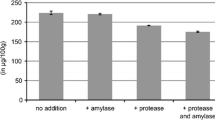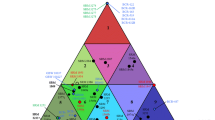Abstract
A wide range of Indian foods (cereals, pulses, vegetables and milk based preparations) were analysed for five folate vitamers naturally present in the foods (n = 44). A liquid chromatography–mass spectrometry (LC–MS/MS) method using reversed phase chromatography and tandem mass spectrometry, coupled via positive mode electrospray ionization was used for the detection and quantification of the vitamers. The optimized LC–MS/MS method was capable of analysing the five most commonly-occurring folates (folic acid, 5-methyl tetrahydrofolic acid, tetrahydrofolic acid, 10-formyl folic acid and 5-formyl tetrahydrofolic acid) in 20 min. Quantification of folates was performed using 13C labelled internal standards. 5-methyl tetrahydrofolate was predominant in cereals, pulses and vegetable preparations. Fermented cereal preparations, beverages (coffee and tea) and green leafy vegetables were the main sources contributing to 5-formyl THF. Folic acid was identified in home-made yoghurt. All the values obtained in the present study using LC–MS/MS were compared to the total folate analysed using the microbiological assay in 2010 to generate data on the same foods. Findings suggest that the data obtained using both techniques showed agreement in the values (total folate calculated by adding the individual vitamers in the case of the LC–MS/MS values) particularly when foods were predominant in 5 methyl tetrahydrofolate.
Similar content being viewed by others
Abbreviations
- LC–MS/MS:
-
Liquid chromatography–tandem mass spectrometry
- SRM:
-
Selected reaction monitoring
- HPLC:
-
High pressure liquid chromatography
- GCMS:
-
Gas chromatography mass spectrometry
- ESI:
-
Electrospray ionisation
- APCI:
-
Atmospheric pressure chemical ionisation
- m/z :
-
Mass to charge ratio
- Rf :
-
Response factor
- SPE–SAX:
-
Solid phase extraction–strong anion exchange
- CID:
-
Collision induced dissociation
- CRM:
-
Certified reference materials
References
Arcot J, Shrestha A (2005) Folate: methods of analysis. Trends Food Sci Technol 16:253–266
Christopherson RI (1996) How folate functions inside the body. Aust J Nutr Diet 53:s8–s10
Czeizel JF, Dudas J (1992) Prevention of first occurence of neural tube defects by periconceptional vitamin supplementation. N Engl J Med 327:1832–1835
Friesleben A, Schieberle P, Rychlik M (2003) Specific and sensitive quantification of folate vitamers in foods by stable isotope dilution assays using high performance liquid chromatography–tandem mass spectrometry. Anal Bioanal Chem 376:149–156
Gjesdal C, Vollset S, Ueland P, Refsum H, Drevon C, Gjessing H, Tell G (2006) Plasma total homocysteine level and bone mineral density: the Hordaland homocysteine study. Arch Intern Med 166:88–94
Krapels IPC, van Rooij IALM, Ocke MC, West CE, van der Horst CMAM, Steegers-Theunissen RPM (2004) Maternal nutritional status and the risk of orofacial cleft offspring in humans. J Nutr 134:3106–3113
Leporati A, Catellani D, Suman M, Andreoli R, Manini P, Niessen WM (2005) Application of a liquid chromatography tandem mass spectrometry method to the analysis of water-soluble vitamins in Italian pasta. Anal Chim Acta 531:87–95
Lucock M (2000) Folic acid: nutritional biochemistry, molecular biology, and role in disease processes. Mol Genet Metab 71:121–138
Muller H (1993) The determination of the folic acid content of foods of animal origin using high performance liquid chromatography (HPLC). Z Lebensm-Unters Forsch 196:518–521
Newman EM, Tsai JF (1986) Microbiological analysis of 5-formyltetrahydrofolic acid and other folates using an automatic 96-well plate reader. Anal Biochem 154:509–515
O’Broin JD, Temperley IJ, Brown JP, Scott JM (1975) Nutritional stability of various naturally occurring monoglutamate derivatives of folic acid. Am J Clin Nutr 28:438–444
Pawlosky R, Flanagan V (2001) A quantitative stable-isotope LC–MS method for the determination of folic acid in fortified foods. J Agric Food Chem 49:1282–1286
Pfeiffer CM, Rogers LM, Gregory JF III (1997) Determination of folate in cereal-grain food products using tri-enzyme extraction and combined affinity and reverse-phase liquid chromatography. J Agric Food Chem 45:407–413
Phillips K, Ruggio D, Ashraf-Khorasanni M, Haytowitz D (2006) Development of accurate and representative food composition data for the US food supply. J Agric Food Chem 54:9998
Rader JI, Weaver CM, Angyal G (1998) Use of a microbiological assay with tri-enzyme extraction for measurement of pre-fortification levels of folates in enriched cereal-grain products. Food Chem 62:451–465
Ringling C, Rychlik M (2013) Analysis of seven folates in food by LC–MS/MS to improve accuracy of total folate data. Eur Food Res Technol 236:17–28
Rychlik M (2004) Revised folate content of foods determined by stable isotope dilution assays. J Food Compos Anal 17(3–4):475–483
Rychlik M, Netzel M, Pfannebecker I, Frank T, Bitsch I (2003) Application of stable isotope dilution assays based on liquid chromatography–tandem mass spectrometry for the assessment of folate bioavailability. J Chromatogr B Analyt Technol Biomed Life Sci 792(2):167–176
Salvi V, Damania K (2005) Neural tube defects in India—time for action. Lancet 366:871–872
Seshadri S, Beiser A, Selhub J, Jaques PF, Rosenberg IH, D’Agostino RB, Wilson PWF, Wolf PA (2002) Plasma homocysteine as a risk factor for dementia and Alzheimer’s disease. N Engl J Med 346:476–483
Seyoum E, Selhub J (1993) Combined affinity and ion pair column chromatography for the analysis of food folate. J Nutr Biochem 4:488–494
Shin YS, Kim ES, Watson JE, Stokstad ELR (1975) Folic acid compounds in nature. IV. Folic acid compounds in soybeans and cow milk. Can J Biochem 53:338–343
Shrestha AK, Arcot J, Paterson J (2000) Folate assay of foods by traditional and tri-enzyme treatments using cryoprotected Lactobacillus casei. Food Chem 71:545–552
Stokes P, Webb K (1999) Analysis of some folate monoglutamates by high-performance liquid chromatography–mass spectrometry. I. J Chromatogr A 864:59–67
Tamura T, Stokstad ELR (1973) The availability of food folate in man. Br J Haematol 25:513–532
Vahteristo L, Lehikoinen K, Ollilainen V, Varo P (1997a) Application of an HPLC assay for the determination of folate derivatives in some vegetables, fruits and berries consumed in Finland. Food Chem 59:589–597
Vahteristo LT, Ollilainen V, Varo P (1997b) Liquid chromatographic determination of folate monoglutamates in fish, meat, egg, and dairy products consumed in Finland. J AOAC Int 80:373–378
Vishnumohan S, Arcot J, Sini S, Uthira L, Ramachandran S (2009) Determination of folate contents in selected Indian foods using the tri-enzyme extraction and estimated folate intakes of the population based on 24-h recall. Int J Food Sci Nutr 60:170–180
Vishnumohan S, Arcot J, Pickford R (2011) Naturally-occurring folates in foods: method development and analysis using liquid chromatography–tandem mass spectrometry (LC–MS/MS). Food Chem 125:736–742
Wigertz K, Jaegerstad M (1995) Comparison of a HPLC and radioprotein-binding assay for the determination of folates in milk and blood samples. Food Chem 54:429–436
Acknowledgements
The mass spectrometric analysis for this work was carried out at the Bioanalytical Mass Spectrometry Facility, UNSW, Sydney, Australia and was supported in part by grants from Australian Government Systemic Infrastructure Initiative and Major National Research Facilities program (UNSW node of Australian Proteome Analysis Facility) and by the UNSW capital Grants Scheme. The authors wish to thank Dr. Naresh Kumar, from the School of Chemistry, The University of New South Wales for his assistance in the synthesis of the carbon-labelled formyl folic acid.
Author information
Authors and Affiliations
Corresponding author
Rights and permissions
About this article
Cite this article
Vishnumohan, S., Pickford, R. & Arcot, J. Naturally occurring folates in selected traditionally prepared foods in Southern India. J Food Sci Technol 54, 4173–4180 (2017). https://doi.org/10.1007/s13197-017-2870-7
Revised:
Accepted:
Published:
Issue Date:
DOI: https://doi.org/10.1007/s13197-017-2870-7




